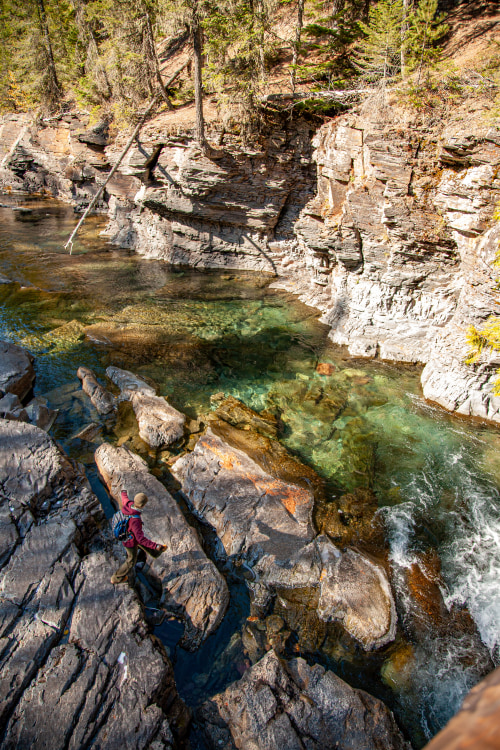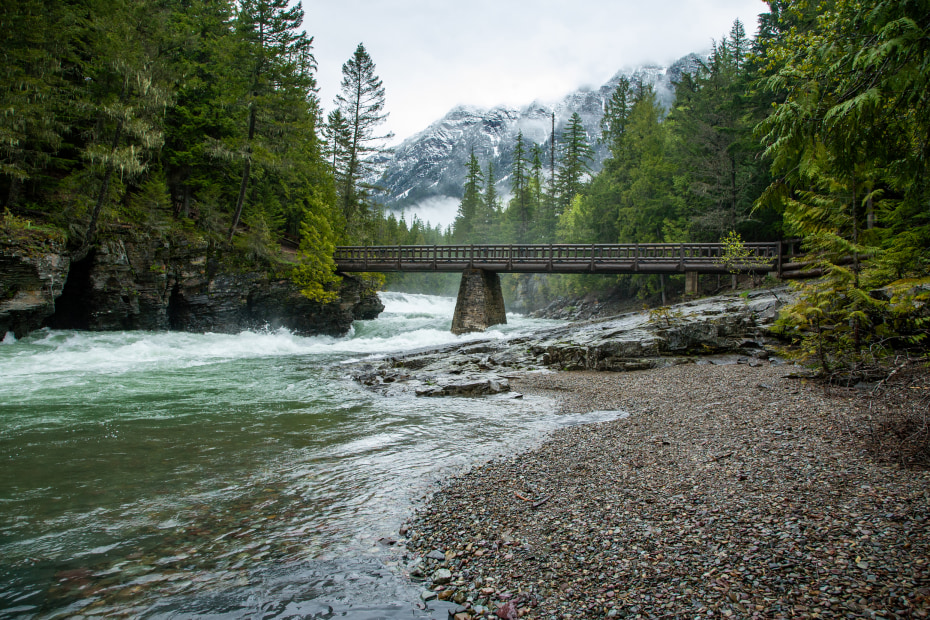Tucked in Montana’s northwest corner, Glacier National Park is a stunning display of turquoise lakes, towering peaks, ancient forests, and expansive valleys, not to mention the dozens of glaciers, the park’s quickly disappearing namesake, which range in size from three square miles to several acres. Together with Canada’s Waterton Lake National Park across the border, this 1,583-square-mile wilderness area makes up the first international peace park and an UNESCO World Heritage Site. Glacier became the country’s 10th national park in May 1910, and it occupies land long inhabited by the Blackfeet and Kootenai American Indians.
With more than 100 mountain summits rising above 8,000 feet, including 10,466-foot Mount Cleveland—the park’s highest peak—Glacier is often called the “Switzerland of North America.” It’s also considered the "Crown of the Continent Ecosystem," a vast landscape that straddles the northern Rocky Mountains and houses an incredible array of native flora and fauna, including lush cedar-hemlock forest, wild huckleberries shrubs, tiny mountain-dwelling pika, and majestic grizzly bears.

Top Sights and Attractions
While the western side of Glacier is the most accessible—an easy drive from nearby Whitefish and Kalispell’s Glacier Park International Airport—the park’s eastern side (specifically its Many Glacier Valley) is where you’ll find some of its most spectacular hikes and scenery, as well as a bevy of wildlife.
Going-to-the-Sun Road
One of the country’s greatest national park drives, the nearly 50-mile Going-to-the-Sun Road connects the park’s two sides. It winds from West Glacier to St. Mary (just outside the park’s eastern boundary) alongside sheer rock walls and past tumbling waterfalls. There are numerous pullouts en route so you can safely gape at the vistas that go on for miles, as well as a visitor center at Logan Pass, which sits at the Continental Divide. At 6,646-feet in elevation, the pass is the highest point in the park reachable by vehicle.
Going-to-the-Sun Road is the only roadway through the park, though it has a limited season that’s highly dependent on weather. The road is typically open from mid-June through mid-October, with reservations required daily from 6 a.m to 3 p.m. July through mid-September.
Smart Tip: A free shuttle is available along Going-to-the-Sun Road on a first-come, first-served basis from early July through Labor Day. It runs both ways, and provides access to lookout points and trailheads.
Lake McDonald
At 10 miles long and more than a mile wide, the breathtaking Lake McDonald surrounded by spruce, fir, and larch trees is the park’s largest body of water. (Glacier is home to approximately 770 lakes, as well 1,500 miles of streams and rivers.) It’s also where you’ll find the Swiss chalet-style Lake McDonald Lodge.
Many Glacier Valley
On the park’s eastern side, north of the Going-to-the-Sun Road, is the iconic Many Glacier Valley, a remote oasis of lakes, waterfalls, peaks, and alpine meadows. The Many Glacier Hotel, another Swiss-style chalet perched on the banks of Swiftcurrent Lake, is the valley’s central hub. A mile up the road sits the Swiftcurrent Motor Inn and Cabins, and a number of popular trailheads, including Grinnell Glacier and Iceberg Ptarmigan.

Things to Do in the Park
There’s so much to do in Glacier, you can easily spend a week or more enjoying its offerings.
Hiking
With more than 700 miles of hiking trails, it’s easy to get into Glacier’s wilderness. Some of the park’s most beloved trails include the 14.9-mile out-and-back Highline Trail, which begins at Logan Pass. Trekking just a short portion of the trail results in fabulous mountain and valley views, and offers a good chance of spotting wildlife. Highlights in Many Glacier Valley include the 9.3-mile Iceberg Lake trail and the 11-mile Grinnell Glacier trail, easily shortened to seven miles by taking boats across Swiftcurrent and Josephine lakes. Lake McDonald boasts the 5.9-mile out-and-back Avalanche Lake trail. In East Glacier’s Two Medicine Valley, situated in the park’s southeast corner, try the 3.5-mile out-and-back trek to Aster Falls.
Smart Tip: Make plenty of noise while hiking so wildlife knows you’re there, and always sign the log before heading out on a trail. It’s important that others know where you are in case of an emergency.
Backpacking
Glacier has dozens of backcountry campgrounds, as well as several thru-hikes that take you from east-to-west (or vice versa) or loop within the heart of the park. The 19.6-mile Gunsight Pass trail is a favorite, with a couple of picturesque lakeside campsites en route. Note: Hikers planning to backcountry camp must obtain a wilderness camping permit from a visitor center or ranger station.
Bus Tours
Take a historic ride through the park on one of Glacier’s red “jammers,” a fleet of 33 vintage buses that got their nickname from the sounds the gears used to make when drivers shifted them over the mountain passes. They’ve been carrying visitors through the park since 1936, and although the buses now have automatic transmissions, their affectionate moniker remains. Each jammer fits 17 passengers and features bench seating and a retractable roof for prime viewing. Both half- and all-day tours are available from either side of the park.

Watercrafts
Interpretive boat tours are available at Many Glacier, Two Medicine, Rising Sun boat dock (located along Going-to-the-Sun Road), and Lake McDonald. You can also rent kayaks, canoes, and paddleboards for use on some of the park’s more prominent lakes, including Lake McDonald and Many Glacier’s Swiftcurrent Lake.
Horseback Riding
Swan Mountain Outfitters is the only business authorized to host horseback riding adventures within the park, from a two-hour ride among Many Glacier’s Cracker Flats to full-day rides to Glacier’s Sperry Chalet.
Viewing Wildlife and Wildflowers
Glacier is known for its incredible array of flora and fauna. Logan Pass and the Many Glacier Valley are good locations for experiencing both. You might see a moose strolling along a pathway or grizzly bears traversing the trails. Mountain goats are often visible grazing on the rocky slopes, while marmots and partridge-like ptarmigans frequent the alpine areas. Keep an eye out for elk and black bears in Glacier’s lower valleys, especially on the park’s east side.
More than half of Glacier National Park is covered in forest, and wildflowers spring to life as the weather warms, bursting in colorful blooms in the park’s upper reaches well into August. Look for white and cream-colored tufts of beargrass and glacier lilies in Glacier’s subalpine areas, purple asters in the Two Medicine Area, and shooting stars and paintbrush leading up to Iceberg Lake. Going-to-the-Sun Road is typically awash in an array of bright blossoms come July and August.
Ranger-led Programs
The park’s larger campgrounds such as Apgar and Two Medicine Valley, along with Many Glacier Hotel, host a range of evening programs throughout summer, including talks on natural and cultural history. The campground amphitheaters are also home to Native America Speaks, a series of evening presentations in which local tribal members share their heritage through singing, storytelling, and workshops. Other seasonal offerings include guided hikes ranging from two to 10 miles, astronomy programs, and Logan Pass star parties. Hour-long tours of Many Glacier Hotel are available during summer months as well.

When to Visit
While the park is technically open year-round, most visitors arrive between late June and mid-September. This is when Going-to-the-Sun Road is most likely to be accessible to vehicles, and the park’s historic lodgings and restaurants are operating in full-gear. It’s also a great time for hitting the trails and catching the wildflowers in bloom, although traffic along the park’s most popular hiking trails can be heavy. Always have a back-up plan and consider less-crowded treks, such as Cracker Lake trail in the Many Glacier Valley or West Glacier’s Huckleberry Lookout. In Glacier National Park, there are no bad views!
Visitation tends to decrease in September through mid-October, meaning you’ll have a better pick of quiet hiking trails. However, both the road into Many Glacier Valley and Going-to-the-Sun Road can close early in the fall, depending on weather. Wildlife is especially active during spring and fall.

Where to Camp and Stay
The park is home to several historic hotels and chalets constructed in Swiss-style architecture in the early 20th century that are still in operation, including Lake McDonald Lodge, Glacier Park Lodge, and Many Glacier Hotel. Village Inn at Apgar, Rising Sun Motor Inn and Cabins, Swiftcurrent Motor Inn and Cabins, Motel Lake McDonald, and Apgar Village Lodge and Cabins offer comfortable rooms with a vintage feel. There are also many places to stay outside the park in gateway towns such as West Glacier, East Glacier, and Whitefish.
There are 13 front-country campgrounds within Glacier, ranging from small, tent-only sites to larger grounds that can accommodate RVs. Most campgrounds are closed in the winter, though Apgar Campground—the park’s largest—has one loop open for winter camping. St. Mary Campground, the largest campground on the park’s east side, offers year-round camping as well. A favorite among visitors, the Many Glacier Campground hosts a mix of first-come first-served and reservation-only sites, as well as restrooms and easy access to trailheads and eateries. Reservations for all bookable campgrounds can be made at Recreation.gov.
When the campgrounds in the park fill up, consider a commercial campground such as the St. Mary/East Glacier KOA Holiday, just outside Glacier’s boundaries.
Know Before You Go
Glacier National Park’s general entrance fee is $35 in the summer ($25 November 1 to April 30) for a seven-day pass. When traveling to the other side of the park, you can also take Montana’s Highway 2, which runs outside Glacier’s southern boundary from Apgar Village—about two miles from Glacier’s west entrance—to East Glacier instead of driving Going-to-the-Sun Road.
Amtrak’s Empire Builder rail line also stretches along the park’s southern border and has stops in both West Glacier and East Glacier. The latter is an easy walk to the historic Glacier Park Lodge, situated at the foot of the Rocky Mountain Front.
Entrances to the park include West Glacier and Polebridge further north on the park’s western side, and St. Mary and Many Glacier Valley on its eastern side.
Weather within the park can change in an instant, so always carry layers—including extra socks and a rain jacket. Refillable water bottles and snacks are also essential, and both insect repellent and bear spray are well-worth carrying.
Recreate Responsibly
Wildlife is one of Glacier National Park’s calling cards, but visitors often forget that these animals are indeed wild. Always stay alert, keep your distance, and never leave your gear unattended.
Follow all other Leave No Trace principles, including storing your food properly and away from your tent, appropriately disposing of your waste, and staying on established trails when hiking.
